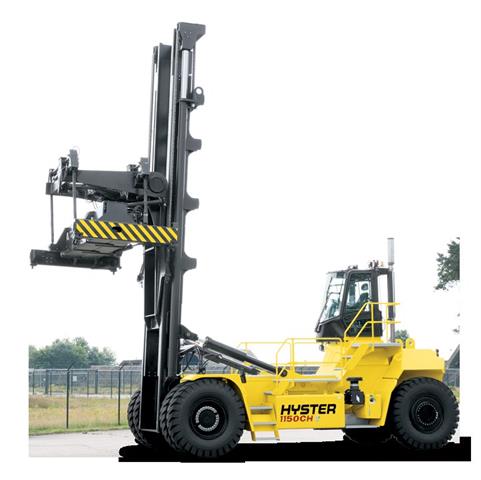 Hyster delivers first of three H1050HD-CH container handlers with Tier IV final engines to a Los Angeles terminal. |
For the fourth quarter ended 31 December, Hyster-Yale Materials Handling Inc reports higher profit but lower sales and sheds light on its acquisition of Nuvera Fuel Cells Inc. Meanwhile, sales for Terex Corp's aerial work platforms (AWP) segment fell from last year.
Hyster-YaleChange is in the wind at Hyster-Yale, with its acquisition of a fuel cell business and its delivery of container handlers with engines meeting the latest emission requirements of the US Environmental Protection Agency.
As announced separately on 24 February, the Hyster brand delivered the first of three H1050HD-CH container handlers with Tier IV final engines to a terminal at the port of Los Angeles for heavy-duty applications. Hyster's H1050-1150HD-CH series features a Cummins engine that is rated at 363 hp. and targeted to lower fuel consumption by up to 20% while delivering hoist speeds of 59 ft. (21.6 m) per minute and load-free lowering speeds of 98 ft. (35.9 m) per minute.
In the financial area, a Hyster-Yale objective is to achieve a 7% operating profit, probably around 2017 at what may be the peak of an economic cycle, says Alfred Rankin, Hyster-Yale chairman, president and chief executive officer. The operating profit of USD148.8 million was about 5.4% on 2014 sales of USD2.77 billion.
On 18 December, Hyster-Yale acquired Nuvera, a privately held development stage company, for USD6.9 million in cash and is reporting its operations as a separate segment from the forklift business. Nuvera is based in Billerica, Massachusetts and has a unit, Nuvera Fuel Cells Europe SrL, in San Donato, Italy.
Hyster-Yale expects growth rates for the global forklift truck market to decelerate during 2015, with modest growth in the Western Europe, Asia Pacific and Chinese markets. Hyster-Yale foresees the Americas, Eastern Europe, the Middle East and Africa markets as relatively flat. A modest decline is anticipated in the Japanese market after sales to that country increased by close to 10% during 2014.
Hyster-Yale expects to complete the move to its newly constructed Brazil plant by the end of the first quarter of 2015 and see production ramping up there.
Regarding the Nuvera initiative, Hyster-Yale believes the fuel cell market for forklift trucks has significant growth opportunities. Further work is needed to commercialise the Nuvera technology. Hyster-Yale expects a net loss of approximately USD13 million to USD15 million at the Nuvera business during 2015. Over two to three years, Hyster-Yale may invest USD40 million to USD50 million pre-tax for additional research and development to commercialise Nuvera's technology broadly and to reach break-even.
The Nuvera purchase is perceived as an opportunity to support four of Hyster-Yale's core strategic initiatives: meeting customer needs, providing lowest cost of ownership, enhancing its independent distribution and increasing its presence in the warehouse products market. Hyster-Yale hopes to provide fuel cells for new unit production, particularly in the Class 1-3 forklift categories, and to market the technology to other forklift brands.
For the comparable three-month fourth quarter, Hyster-Yale says profit was USD26.4 million on 2014 sales of USD710.7 million versus profit of USD25.7 million on 2013 sales of USD717.9 million. Sales increased in the Americas market but declined in the Europe and Asia Pacific regions.
Mayfield Heights-based Hyster-Yale had full-year profit of USD109.8 million on 2014 sales of USD2.77 billion versus profit of USD110 million on 2013 sales of USD2.667 billion.
TerexThe Terex AWP business dipped during the fourth quarter as the firm "curtailed production to align our product-build schedules more closely with actual demand and machine configuration in our order book", says Ronald DeFeo, Terex chairman and chief executive officer. "Importantly, however, AWP backlog increased 137.2% when compared with the prior year, giving us confidence that 2015 will be another solid year for this segment." The majority of the year-over-year increase in year-ending AWP backlog - to USD698.4 million from USD294.4 million - relates to timing differences in order patterns from large AWP rental customers, Terex says.
DeFeo notes that AWP's 2013 fourth quarter performance "was particularly strong as we focused on producing equipment during that traditionally softer demand period to capture incremental demand in the quarter as well as level the production load on our factories".
For the comparable fourth quarters, AWP had 2014 sales of USD468.2 million versus 2013 volume of USD482.0 million. For the calendar years, AWP sales were USD2.37 billion during 2014 and USD2.13 billion during 2013.
DeFeo attributes the recent AWP downsides to manufacturing inefficiencies, rising materials costs and the startup cost of the Oklahoma City facility for production of Genie telehandlers.
Terex is ramping production on a broader range of AWPs in China, now manufacturing 11 models there.
Caution about buying equipment exists in the broader market with regard to the issues from oil and gas headwinds and the strong dollar, says Matthew Fearon, Terex AWP segment president. Independent rental companies appear to be taking a cautious approach along with other portions of the AWP customer base.
For the corporation, Westport-based Terex reports profit of USD259.0 million from continuing operations on 2014 sales of USD7.31 billion. In 2013, Terex had profit of USD209.0 million on sales of USD7.08 billion. In addition to AWP, Terex has four other business segments: construction, cranes, materials handling-port solutions and materials processing.